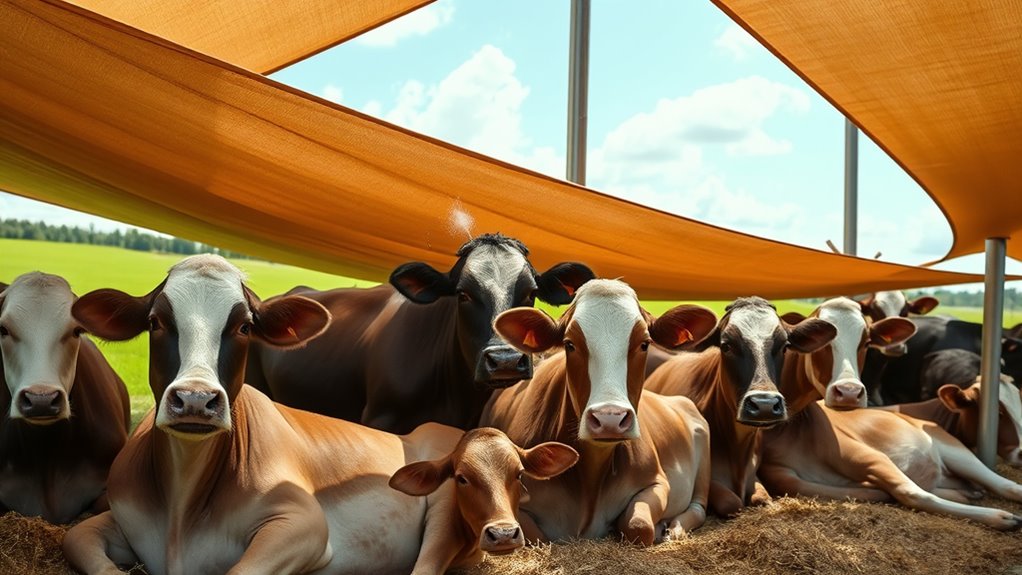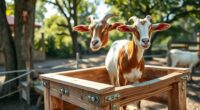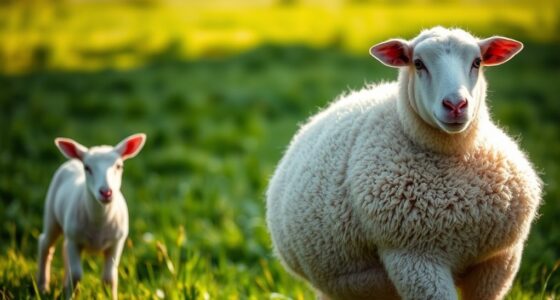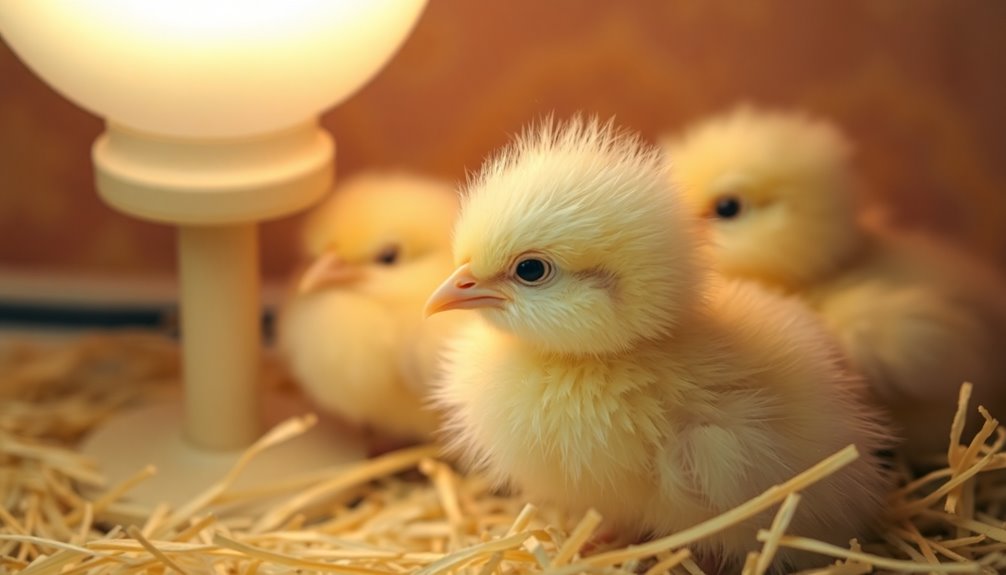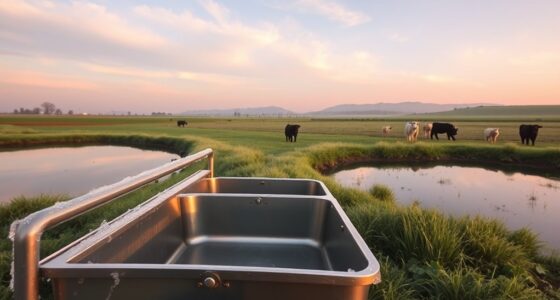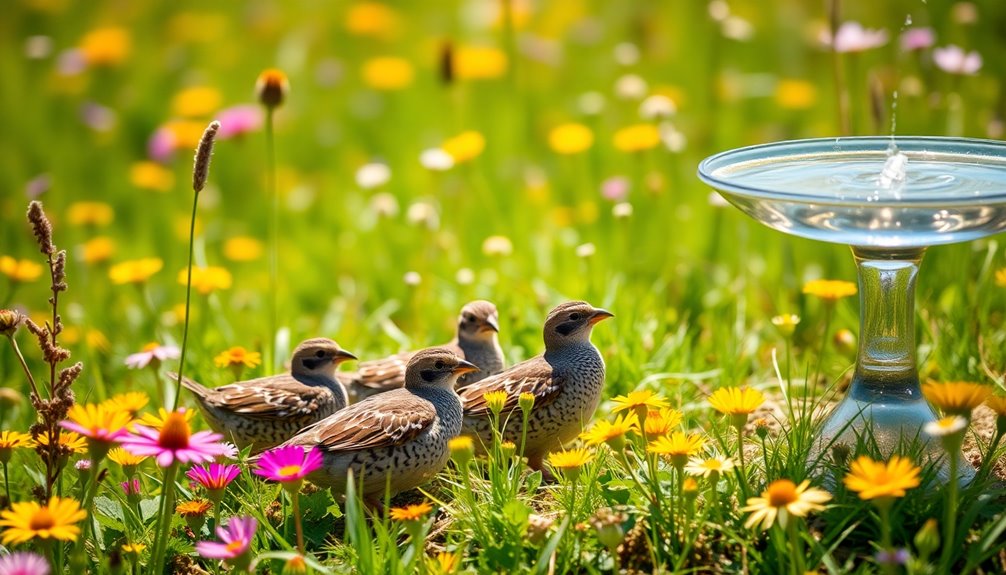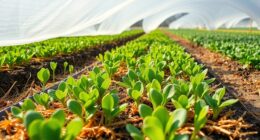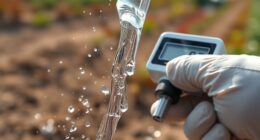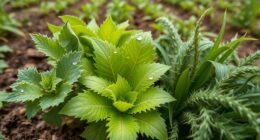To beat the heat, provide ample shade and guarantee good airflow around your cows. Use evaporative cooling systems like fans and misters, especially during peak heat hours. Adjust feeding times and diets to favor easily digestible nutrients, and always keep fresh water available. Monitor signs of heat stress such as rapid respiration or lethargy, and take quick action. Staying ahead of these strategies can help keep your herd healthy and productive during summer’s hottest days.
Key Takeaways
- Provide ample shade and ensure proper ventilation to reduce solar radiation and improve airflow around cows.
- Use cooling systems like fans, misters, and evaporative pads during peak heat hours.
- Adjust feeding schedules to cooler times and offer easily digestible, nutritious diets with constant fresh water access.
- Monitor cows for signs of heat stress, including rapid respiration, drooling, and lethargy, and respond promptly.
- Implement pasture management strategies, such as rotation and reducing overgrazing, to minimize heat load on animals.
Understanding Heat Stress and Its Impact on Dairy Cattle

Heat stress occurs when dairy cows are unable to dissipate enough body heat to maintain a normal temperature, especially during mid-summer when temperatures and humidity levels rise. Cows with strong genetic resilience are better equipped to handle these conditions, as their genes help them manage heat more effectively. You’ll notice behavioral adaptations, such as seeking shade, reducing feed intake, or spreading out to cool areas, as natural responses to overheating. These behaviors are essential for survival and productivity, but they can also impact milk production and overall health. Recognizing these signs early helps you understand how heat stress affects your herd. Additionally, genetic resilience plays a crucial role in a cow’s ability to withstand high temperatures and maintain optimal health. By understanding both genetic resilience and behavioral adaptations, you can better anticipate and address the challenges posed by high temperatures. Furthermore, selecting for heat tolerance in breeding programs can improve herd resilience over time.
Implementing Effective Cooling Systems and Shade Structures
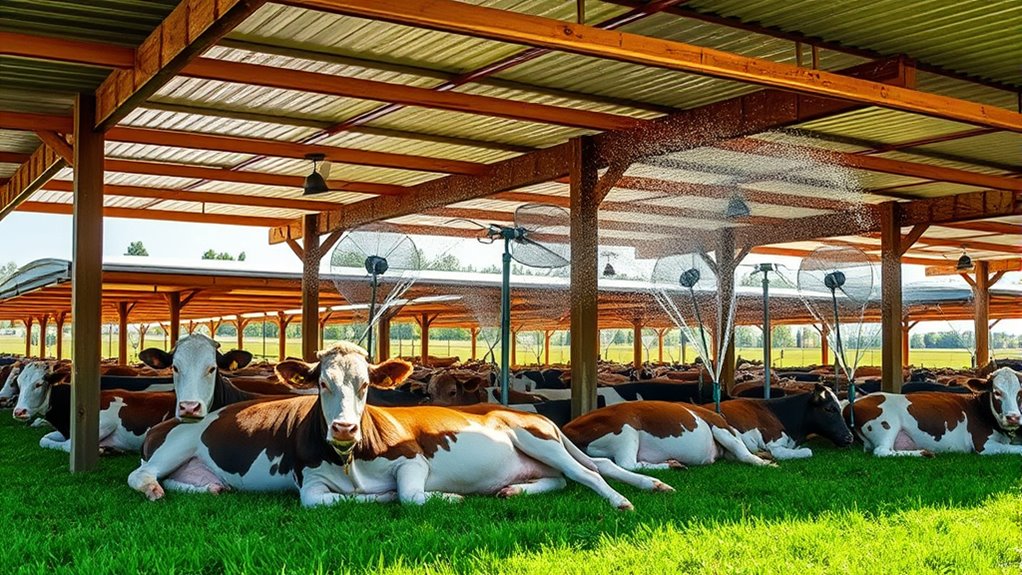
To effectively reduce thermal stress during mid-summer, implementing well-designed cooling systems and shade structures is essential. Evaporative cooling methods, such as misting systems and fans, help lower barn temperatures and improve cow comfort. Shade provision is equally important; it reduces direct solar radiation and offers cows relief from the heat. When designing these systems, consider:
- Proper placement of shade structures to maximize coverage
- Using evaporative cooling units that suit your herd size
- Ensuring good airflow around cooling devices and shaded areas
- Incorporating AI-driven monitoring systems to optimize cooling efficiency and track temperature fluctuations
These strategies work together to create a cooler environment, minimize heat stress, and maintain milk production. Proper implementation of cooling and shade not only enhances animal welfare but also promotes overall herd health during the hottest months.
Optimizing Feeding Strategies During Hot Weather
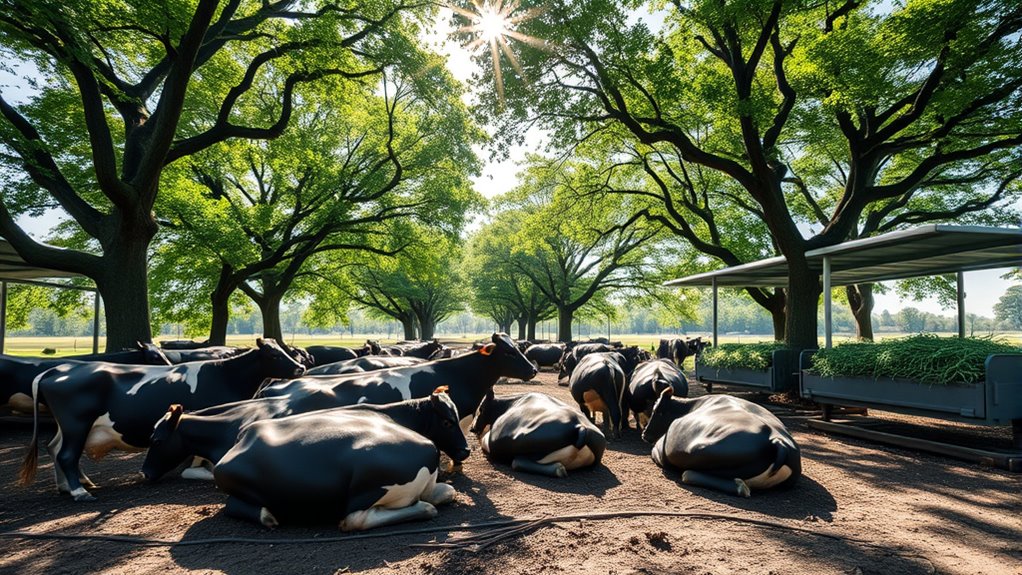
During hot weather, adjusting your feeding strategies is crucial to maintaining dairy cow health and productivity. Focus on providing a balanced feeding regimen that meets nutritional needs without overloading their digestive system. Prioritize high-quality forage, as forage quality directly influences milk production and overall well-being. Consider offering smaller, more frequent meals to reduce rumen stress and prevent metabolic issues. Incorporate easily digestible feeds and limit the intake of concentrates that may cause heat production during digestion. Guarantee clean, fresh water is always accessible to help cows stay hydrated. Water availability is essential for thermoregulation and preventing dehydration in hot conditions. Ensuring proper feeding management can also minimize digestive disturbances and improve overall comfort. Proper diets tailored to hot weather conditions can further enhance cow resilience during heat stress. Avoid sudden diet changes that could upset digestion, and monitor feed intake closely. These adjustments help cows stay comfortable, maintain energy levels, and sustain milk yield despite the heat. Additionally, implementing tuning techniques can optimize equipment performance to ensure consistent cooling systems, thus supporting cow comfort during peak temperatures. Regularly checking and maintaining cooling systems like fans and misters is vital for effective heat stress mitigation.
Monitoring and Managing Cattle Health in High Temperatures

Monitoring and managing cattle health in high temperatures is essential to prevent heat-related stress and guarantee ideal productivity. Pay close attention to animal behavior, such as increased grazing or seeking shade, which signals discomfort. Regularly check for signs of heat stress, including rapid respiration or lethargy. Effective pasture management helps reduce heat load; ensure cows have access to shaded areas and avoid overgrazing that limits shade availability. Keep an eye on body condition and hydration levels, adjusting as needed. Trust issues with animals or inconsistent behavior can also indicate underlying stress or health concerns that require attention. Incorporating glycolic acid benefits in skincare routines can help improve skin health and resilience, which may be beneficial for animals exposed to sun and heat. Observe changes in animal behavior for early warning signs. Maintaining adequate ventilation and airflow in shelter areas is crucial for cooling. Proper shade management techniques can significantly reduce heat stress and improve overall comfort. Rotate grazing to prevent overexposure and manage pasture heat load, while also considering behavioral cues to optimize animal well-being.
Promoting Hydration and Electrolyte Balance for Resilience
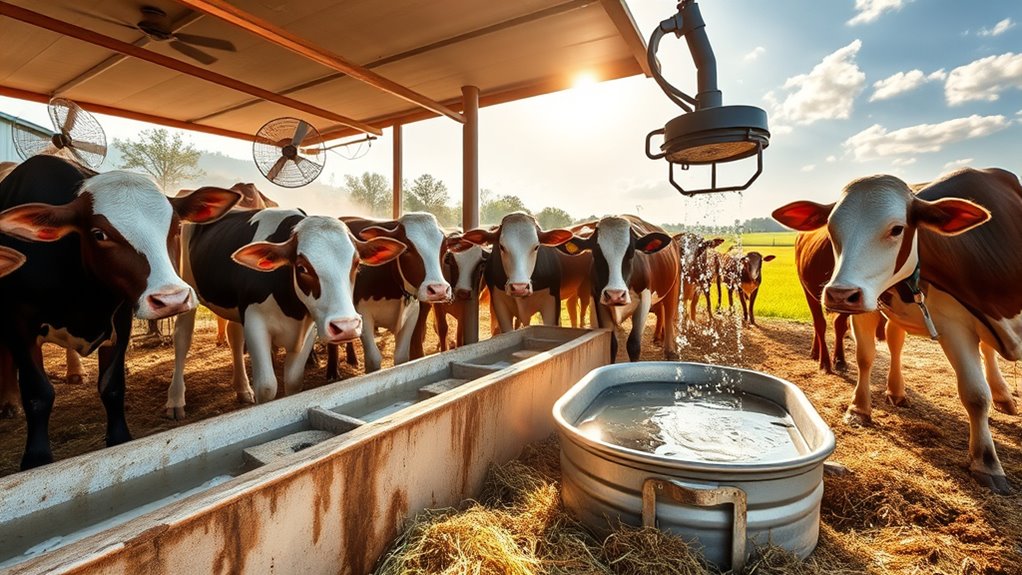
Ensuring that dairy cows stay properly hydrated and maintain their electrolyte balance is essential for their resilience during hot summer days. You can achieve this by implementing effective water intake strategies, such as providing clean, fresh water at multiple accessible locations. Monitor water consumption closely, especially during peak heat, to prevent dehydration. Water accessibility is crucial, so consider installing additional drinkers or fountains if needed to meet increased demand. Electrolyte supplementation is also vital; offering electrolyte solutions helps replace lost minerals and supports muscle function and overall health. Incorporate electrolytes into drinking water or feed as needed, particularly during periods of high heat stress. To maximize effectiveness, convenient delivery methods should be used to ensure cows consume adequate electrolytes without difficulty. Using wall organization systems to keep feed and water stations orderly can encourage consistent access. Additionally, proper ventilation in housing areas can help reduce heat buildup and improve comfort. Proper management of these factors can significantly reduce heat stress and promote better overall health and productivity. Consistent hydration and balanced electrolytes help reduce heat stress, improve milk production, and promote faster recovery from heat-related fatigue. Stay vigilant and proactive to keep your cows comfortable and resilient throughout the summer.
Frequently Asked Questions
How Can I Identify Early Signs of Heat Stress in Dairy Cows?
To identify early signs of heat stress in your dairy cows, observe behavior changes, respiratory signs, and reduced activity. Cows may seek shade, pant more, or become restless. You’ll notice increased breathing rate, drooling, and reluctance to move. These indicators show discomfort early on, so paying close attention helps you act quickly. Recognizing these signs allows you to implement cooling strategies promptly, keeping your cows healthy and productive during hot days.
What Are Cost-Effective Cooling Options for Small-Scale Dairy Farms?
You can keep costs down by using evaporative cooling systems like misters or fans, which help lower cow temperature effectively. Providing ample shade, whether with trees or shade cloths, also offers relief without high expenses. Combining shade provision with evaporative cooling creates a simple, affordable way to manage heat stress on small farms, boosting cow comfort and productivity while saving money.
How Does Heat Stress Affect Milk Quality and Yield Long-Term?
Heat stress can considerably reduce your dairy cows’ milk yield and alter milk composition over time. It weakens their immune system and affects genetic resilience, making them more vulnerable to illness. Long-term, this leads to decreased productivity and compromised milk quality. To mitigate these effects, focus on improving cooling strategies and selecting heat-tolerant breeds, which help maintain ideal milk production and preserve milk quality despite rising temperatures.
Are There Breed Differences in Heat Tolerance Among Dairy Cattle?
When it comes to breed resilience, you’ll notice some dairy cattle handle heat better than others, thanks to genetic adaptation. Certain breeds, like Brahman or Zebu, are built like a tank against hot weather, showcasing natural heat tolerance. Others, such as Holsteins, are more vulnerable. Recognizing these breed differences helps you select cows better suited for your climate, turning the heat from a hurdle into an advantage.
What Are Natural Remedies to Help Cows Cope With High Temperatures?
You can help your cows cope with high temperatures by using natural remedies like herbal supplements that support hydration and cooling. Electrolyte solutions are also effective in replenishing lost minerals and preventing heat stress. Providing plenty of fresh water, shade, and good ventilation enhances their comfort. Combining these strategies helps your cows stay healthy, reduces stress, and maintains milk production during hot weather.
Conclusion
As summer’s heat presses down like a heavy blanket, you can keep your dairy cows cool and comfortable. Picture them resting under shaded shelters, their bodies relaxed, breaths steady. By implementing smart cooling, feeding wisely, and ensuring plenty of fresh water, you create a sanctuary of relief amid the scorching days. With your attentive care, your herd stays resilient, thriving through the heat, ready to produce, and stay healthy—turning summer’s challenge into a demonstration of your dedication.

